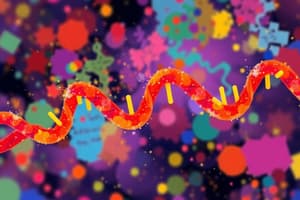Podcast
Questions and Answers
What is the main enzyme responsible for catalyzing the formation of RNA molecules from DNA templates in prokaryotic transcription?
What is the main enzyme responsible for catalyzing the formation of RNA molecules from DNA templates in prokaryotic transcription?
- RNA Polymerase (correct)
- Ligase
- DNA Polymerase
- RNA Helicase
Which of the following sequences are recognized by RNA polymerase during the initiation of prokaryotic transcription?
Which of the following sequences are recognized by RNA polymerase during the initiation of prokaryotic transcription?
- Intron
- TATA box
- Pribnow box (correct)
- Enhancer region
What role do consensus sequences like the Pribnow box and the -10 site play in prokaryotic transcription?
What role do consensus sequences like the Pribnow box and the -10 site play in prokaryotic transcription?
- They encode proteins directly
- They serve as targets for RNA polymerase binding (correct)
- They recruit ribosomes
- They are involved in DNA replication
Which step of prokaryotic transcription involves the recruitment and assembly of RNA polymerase at the promoter site?
Which step of prokaryotic transcription involves the recruitment and assembly of RNA polymerase at the promoter site?
What allows RNA polymerase to access the DNA template during prokaryotic transcription without requiring additional helicases?
What allows RNA polymerase to access the DNA template during prokaryotic transcription without requiring additional helicases?
What is the direction of mRNA synthesis during transcription?
What is the direction of mRNA synthesis during transcription?
Which nucleotide replaces thymine in RNA molecules?
Which nucleotide replaces thymine in RNA molecules?
What is the role of RNA polymerase in maintaining transcription integrity?
What is the role of RNA polymerase in maintaining transcription integrity?
In rho-independent termination, what leads to the stalling of RNA polymerase?
In rho-independent termination, what leads to the stalling of RNA polymerase?
How do transcription factors influence gene expression?
How do transcription factors influence gene expression?
Flashcards are hidden until you start studying
Study Notes
Prokaryotic Transcription
Overview
Prokaryotic transcription involves the conversion of genetic information stored in DNA into functional RNA molecules. This process consists of initiation, elongation, termination, and the involvement of regulatory proteins known as transcription factors.
RNA Polymerase
RNA polymerase is the key enzyme responsible for catalyzing the formation of RNA molecules from DNA templates. It recognizes and binds specifically to certain sequences within the DNA, called promoters, and uses them as starting points for transcription.
Initiation
Initiation of transcription involves the recruitment and assembly of the RNA polymerase at the promoter site. The recognition of promoter sequences relies on the presence of consensus sequences such as the Pribnow box (-35) and the promoter -10 site, both located upstream of the actual start of transcription (+1).
Consensus Sequences
These consensus sequences serve as targets for the binding of RNA polymerase and play crucial roles in determining which genes are transcribed and how frequently. They are highly conserved across various bacterial species, ensuring a uniform mechanism for gene expression.
DNA Unwinding
Once bound to the promoter site, RNA polymerase is capable of unwinding the DNA without the need for additional helicases. This process, known as DNA melting, allows the enzyme to access the underlying DNA template.
Elongation
After initiation, RNA polymerase starts to move along the DNA template, synthesizing mRNA in the 5' to 3' direction. The DNA is continually unwound ahead of the polymerase and refolded behind it to accommodate the ongoing transcription process.
Base Complementarity
As the nascent RNA strand grows, it matches the template DNA in a complementary manner, forming base pairs with its opposite strand. However, since RNA contains uracil instead of thymine, these base pairs are weak compared to those found in DNA. Despite this weakness, the base complementarity ensures the accuracy of the RNA copy.
Stable Linker
To maintain the integrity of the transcription machinery, RNA polymerase acts as a stable linker between the DNA template and the nascent RNA strands, preventing the premature dissociation of these components.
Termination
Termination of transcription marks the completion of an individual transcription event. This process occurs when RNA polymerase dissociates from the DNA template, releasing the newly synthesized mRNA.
Rho-Dependent Termination
In rho-dependent termination, the rho protein is involved in the process. When the RNA polymerase encounters a run of guanine nucleotides on the DNA template, it stalls, causing the rho protein to collide with the polymerase. This collision leads to the release of the mRNA from the transcription bubble, effectively halting further transcription.
Rho-Independent Termination
Alternatively, rho-independent termination occurs when the RNA polymerase stalls upon encountering a stable hairpin structure formed by a region of complementary cytosine-guanine (C-G) nucleotides within the transcribed mRNA. The resulting intramolecular interactions lead to the stalling of the RNA polymerase and the subsequent release of the mRNA.
Transcription Factors
Regulatory proteins known as transcription factors play a critical role in modulating gene expression by either enhancing or inhibiting transcription. They can interact with the DNA at specific locations to either stabilize or destabilize the transcription complex, thereby influencing the overall transcription process.
Studying That Suits You
Use AI to generate personalized quizzes and flashcards to suit your learning preferences.




